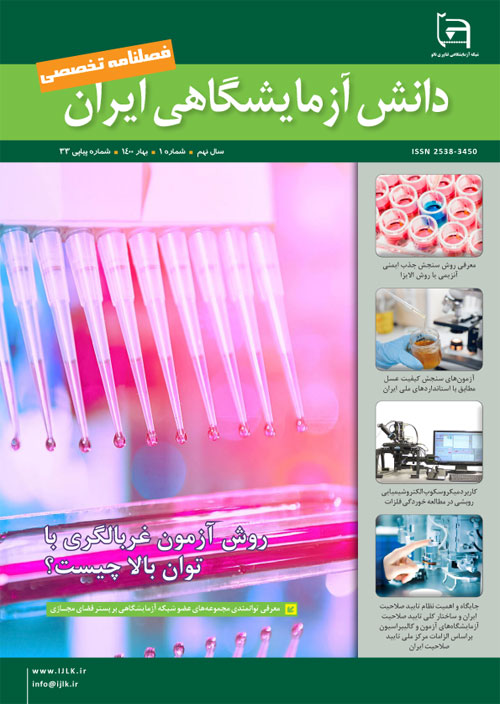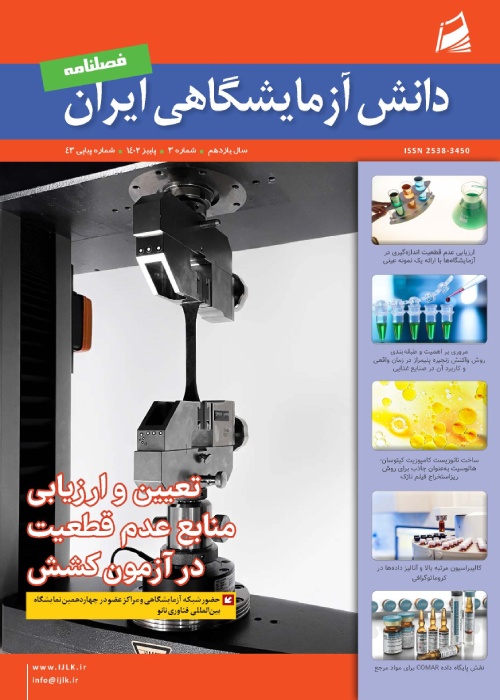فهرست مطالب

مجله دانش آزمایشگاهی ایران
سال نهم شماره 1 (پیاپی 33، بهار 1400)
- تاریخ انتشار: 1400/03/22
- تعداد عناوین: 6
- اخبار
-
معرفی توانمندی مجموعه های عضو شبکه آزمایشگاهی بر بستر فضای مجازی / فضای مجازی میزبان توانمندی اعضای شبکه آزمایشگاهیصفحه 2
- مقالات
-
معرفی روش سنجش جذب ایمنی آنزیمی یا روش الایزا / بخش اول - اصول و کاربردهای آنصفحه 5
-
روش آزمون غربالگری با توان بالا چیست؟ / بخش دوم: راهبرد و کاربردها در پژوهش های شیمیصفحه 37
-
Introduction of Enzyme-Linked Immunosorbent Assay (ELISA) method / Part 1 Principles and applicationsPage 5
The ELISA technique is an immunochemical method for determining the amount of an antibody or antigen molecule. In this technique, the solid phase is used to create a suitable subs trate for binding to an antigen or antibody. The enzyme attached to the antigenantibody complex is then used to convert the appropriate subs trate into a dye product. The rate of conversion of a colorless subs trate to a dye product by an enzyme, which indicates the presence of an antigen or antibody and also its concentration, it can be determined by measuring the optical density with a spectrophotometer. This s tudy aims to introduce the ELISA technique, its applications, advantages, disadvantages, challenges and important parameters in improving the results.
Keywords: ELISA, Antigen, Antibody, Immune Complex, Conjugated Enzyme, Subs trate, Colorimetric assay -
Page 15
The mos t valid method for determining the quality of honey and knowing its purity is laboratory methods. Analyzing natural honey is not an easy and fas t method, and even despite the claims of some centers, the diagnosis of natural honey, confirmation of the quality of honey and validation of its analysis data is s till controversial. However, factors such as measuring the percentage of reducing sugars and sucrose, measuring fructose to glucose ratio, measuring hydroxymethyl furfural (HMF), determining the amount of dias tase activity, measuring proline, mois ture, free acidity, conductivity, ash and pes ticide residues of Honey are some factors that can be done using common laboratory equipments such as pH meters, conductivity meters and furnaces to more specific equipments such as spectrophotometers, gas chromatograph (GC) and high performance liquid chromatograph (HPLC) which allows producers and consumers to be aware of the quality of the honey. In this article, we introduce tes ts and acceptable limits for natural honey by introducing laboratory tes ts and reviewing the national s tandards of Iran.
Keywords: reducing sugars, sucrose, hydroxymethyl furfural(HMF), dias tase activity, proline, honey -
Page 22
Due to the necessity of international interactions and protection of the country’s interes ts in the field of trade and commerce at the national and international levels, the “National Accreditation Center of Iran” is es tablished and managed as an independent and impartial sys tem to provide certification services. The National Accreditation Center of Iran, in order to gain international accreditation in the field of certification of certification bodies, through the process of parity assessment by the “Asia- Pacific Accreditation Association” (PAC). Also, in implementing the general policies of Article 44 of the Cons titution, the Center is responsible for delegating part of the government’s holdings to accredited ins titutions, and through interaction with other countries’ accreditation bodies, the executive affairs of the national regis tration of certification certificates are issued. It has compliance for its assessment agencies on its agenda. One of the tasks that can be transferred by the center is to certify the qualification of tes t and calibration laboratories according to ISO / IEC 17025 s tandard. Center-approved laboratories can work as subcontractors or as a partner laboratory with the National S tandards Organization or other applicants for tes ting and calibration services. In this article, while explaining the accreditation procedures of the National Accreditation Center of Iran, with the introduction of S tandard 17025, general requirements for competence, impartiality and coherence of laboratory operations, s tructural requirements, resources, facilities and environmental conditions, equipment, cognitive traceability, requirements Process, sampling, technical records, assessment of measurement uncertainty, assurance of results and reporting of results are provided according to s tandard 17025, which can be used by all organizations that have laboratory activities.
Keywords: Certification of conformity, Tes ting Laboratory, Calibration Laboratory, ISO, IEC 17025 s tandard -
Page 31
Since the inception of the Scanning Electrochemical Microscope (SECM), it has been used to inves tigate the local corrosion of high spatial and temporal resolution sys tems. SECM is a unique scanning technique used electrochemically for the detection of chemicals and electrochemical activities in heterogeneous electrochemical sys tems such as corrosion inves tigations. It is also used to s tudy the initiation and propagation of cavities, surface micros tructures, electron transfer kinetics as well as the effectiveness of various protection schemes including coatings, inhibitors and enhancers.
Keywords: Scanning electrochemical microscope, Metal Corrosion, Pitting, Redox mediator -
Page 37
High-throughput experimentation (HTE) or High-throughput screening (HTS) is revolutionary method in the pharmaceutical, biological and chemical indus tries, especially in the field of pharmacy, has enabled the rapid screening of large-volume hybrid libraries for various therapeutic research purposes. The pas t decade has also witnessed the extension of HTS principles toward field of chemis try and catalys ts. Today, mos t major pharmaceutical, biological and chemical companies have created dedicated HTE Sys tems. In the second part of the article, an example of the implementation method, challenges and application of this technique in the field of chemical research will be introduced. Illustrative examples have been carefully chosen to inspire, rather than prescribe, how HTE can be used to solve complex problems in synthesis. Furthermore, the intent is to present HTE not jus t as a tool for expert users in highly automated laboratories, but as an enabling approach to reaction discovery, development, and optimization that can be broadly employed by all chemis ts conducting research.
Keywords: HTS, HTE, High-Throughput Experimentation, Chemis try, Catalys ts, HPLC, UPLC, Array, Solvents, Ligands


